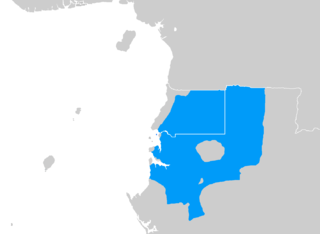Related Research Articles

Fang is a Central African language spoken by around 1 million people, most of them in Equatorial Guinea, and northern Gabon, where it is the dominant Bantu language; Fang is also spoken in southern Cameroon, the Republic of the Congo, and small fractions of the islands of São Tomé and Príncipe. It is related to the Bulu and Ewondo languages of southern Cameroon.
Basaa, or Mbene, is a Bantu language spoken in Cameroon by the Basaa people. It is spoken by about 300,000 people in the Centre and Littoral regions.
Bulu is a Bantu language of the Bulu people of Cameroon. The language had 174,000 native speakers in 1982, with some 800,000 second language speakers in 1991. Its dialects include Bene, Yelinda, Yembana, Yengono, and Zaman. Bulu was formerly used by colonial and missionary groups as a lingua franca in the region for commercial, educational, and religious purposes, though it is today becoming less frequent in those spheres.
Ewondo or Kolo is the language of the Ewondo people of Cameroon. The language had 577,700 native speakers in 1982. Ewondo is a trade language. Dialects include Badjia (Bakjo), Bafeuk, Bamvele, Bane, Beti, Enoah, Evouzok, Fong, Mbida-Bani, Mvete, Mvog-Niengue, Omvang, Yabekolo (Yebekolo), Yabeka, and Yabekanga. Ewondo speakers live primarily in Cameroon's Centre Region and the northern part of the Océan division in the South Region.
Kako is a Bantu language spoken mainly in Cameroon, with some speakers in the Central African Republic and the Republic of the Congo. The main population centres of Kako speakers are Batouri and Ndélélé in the East Region of Cameroon.
Afade (Afaɗə) is an Afro-Asiatic language spoken in eastern Nigeria and northwestern Cameroon.
Maslam is an Afro-Asiatic language spoken in northern Cameroon, with a few in southwestern Chad. Dialects are Maslam and Sao. Maslam is in rapid decline.
The Fanji language, Chuufiè (chufieʼ), is a Grassfields Bantu language and the language of the Bafanji people in the Northwest Region of Cameroon. There are approximately 17,000 speakers. The language has a rich system of tonal morphology, including reduplication involving adjectives.
Bankon is a Bantu language spoken in the Moungo department of the Littoral Province of southwestern Cameroon. It has a lexical similarity of 86% with Rombi which is spoken in the nearby Meme department of Southwest Province.

The Kwasio language, also known as Ngumba / Mvumbo, Bujeba, and Gyele / Kola, is a language of Cameroon, spoken in the south along the coast and at the border with Equatorial Guinea by some 70,000 members of the Ngumba, Kwasio, Gyele and Mabi peoples. Many authors view Kwasio and the Gyele/Kola language as distinct. In the Ethnologue, the languages therefore receive different codes: Kwasio has the ISO 639-3 code nmg, while Gyele has the code gyi. The Kwasio, Ngumba, and Mabi are village farmers; the Gyele are nomadic Pygmy hunter-gatherers living in the rain forest.
Baka is a dialect cluster of Ubangian languages spoken by the Baka Pygmies of Cameroon and Gabon. The people are ethnically close to the Aka, the two together called the Mbenga (Bambenga), but the languages are not related, apart from some vocabulary dealing with the forest economy, which suggests the Aka may have shifted to Bantu, probably 15000 people have shifted.
Nzime (Koonzime) is a Bantu language of Cameroon, spoken by the Nzime and Dwe'e (Bajwe'e) people. Maho (2009) lists these as two languages.
Kogo, also referred to as Bakoko and Basoo, is a Bantu language of Cameroon. North and South Kogo are as distinct from each other as they are from Basaa; they might be considered three dialects of a single language.
Makaa (Maka), or South Makaa, is a Bantu language of Cameroon. It is not intelligible with the other language spoken by the Makaa people, North Makaa.
Pol is a Bantu language of Cameroon. Pol proper is spoken in central Cameroon; the Pomo and Kweso dialects are spoken in Congo and the CAR near the Cameroonian border.
Jina (Zina) is an Afroasiatic language of Cameroon. The Muxule variety may be a distinct language.
Mpumpong (Mpongmpong) is a Bantu language of Cameroon. Maho (2009) considers Mpiemo to be a dialect.
Kwakum is classified as belonging to the Bantu subgroup A90 (Kaka) of the Zone “A” Bantu languages, and specifically labelled A91 by Guthrie. According to one of the newest updates to the Bantu classification system, other languages belonging to this subgroup are: Pol (A92a), Pɔmɔ (A92b), Kweso (A92C) and Kakɔ (A93). The Kwakum people refer to themselves as either Kwakum or Bakoum. However, they say that the "Bakoum" pronunciation only began after the arrival of Europeans in Cameroon, though it is frequently used today. Kwakum is mainly spoken in the East region of Cameroon, southwest of the city Bertoua.
Bebele is a Bantu language of Cameroon. It is mutually intelligible with other Beti dialects such as Ewondo and Fang.
Bebil (Gbïgbïl) is a Bantu language of Cameroon. It is mutually intelligible with other Beti dialects.
References
- ↑ Swo at Ethnologue (18th ed., 2015)
- ↑ Jouni Filip Maho, 2009. New Updated Guthrie List Online
- ↑ Bryan, Margaret Arminel, compiler, The Bantu Languages of Africa, Oxford University Press, 1959.
- ↑ Binam Bikoi, Charles, ed. (2012). Atlas linguistique du Cameroun (ALCAM)[Linguistic Atlas of Cameroon]. Atlas linguistique de l'Afrique centrale (ALAC) (in French). Volume 1: Inventaire des langues. Yaoundé: CERDOTOLA. ISBN 9789956796069.
|volume=has extra text (help)